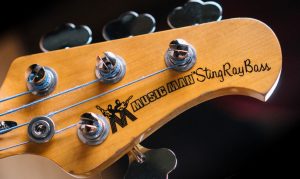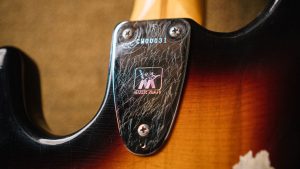An insight into one of the most ambitious Ernie Ball Music Man projects to date.
Cliff Williams might be one of the most unheralded names in rock ’n roll. As the longtime bassist for AC/DC, he’s been holding down the low-end with the legendary Aussie rockers for more than forty years, opting for the a vintage Music Man StingRay to lay down his rocksteady basslines both onstage and in the studio.
This year, Ernie Ball Music Man have celebrated Williams with the release of the Cliff Williams Icon Series StingRay: a limited edition replica of the bassist’s ‘Number #1 Workhorse’ that saw the company go to painstaking lengths in order to create. To find out more about the intriguing process behind the creation of the bass, we spoke with Ernie Ball engineer Blair Ridings and Artist Relations Manager Derek Brooks to hear just how the debut model in their new Icon Series came together.
Hey guys, it’s a pleasure to chat with you. How’s everything doing over your way in the States right now?
This year has definitely been challenging. A lot of changes were made to our factory and employee environment, but luckily, the Ball family was on top of things from the start and were able to keep us working and continuing to develop new products.
Tell us about the new Cliff Williams StingRay bass. How long have you had this project in the works for? Was Cliff heavily involved in the process himself?
This was a two year endeavour. Mr. Williams was heavily involved throughout, and he was great about giving us feedback on each of the many initial prototypes. We knew it was paramount that Cliff was happy with the result before moving forward with any type of production run.

This is the first time you’ve revived a model that predates the Ernie Ball takeover. Given how they’ve evolved over the years, what was it like to recreate one of the first StingRays from the Music Man era?
It was fascinating to dissect the subtle differences between Pre-EB StingRays and those from the periods that followed until now. The allure for this era of the StingRay is not just for its age and history – the functionality and tonal qualities also completely set them apart. The body and neck woods, contours, truss rod design, pickup, preamp, bridge, neck plate, and hardware are all significantly different from StingRays that followed.
Would there ever be another opportunity where you’d look all the way back to the ‘70s for a particular reissue or signature model?
Yes, the Cliff Williams bass is first in a series of Icon instruments played by artists over the years. To follow up, we may include famous players that used pre-EB Music Man StingRay basses from that same era as well. We’re also looking at some vintage Ernie Ball Music Man guitars from previous years to replicate as part of this same series.

The Cliff Williams signature bass also features significant road wear across the body and neck, which is also a new feature to Ernie Ball Music Man instruments. What processes did you go through to replicate this?
We tried just about everything under the sun to finally get the desired results. Each process that proved successful mimicked the same basic steps of degradation that were experienced throughout a +40 year rock n’ roll lifestyle.
The body and neck were painted entirely with period correct nitrocellulose lacquer, buffed like new, then worn down to bare wood in the exact places through sanding, scraping, rubbing, gouging and chaining all done by hand. The areas to be worn away were perfectly marked by an extremely light laser etching into the paint to be used as a template. The bare wood areas were then hand-painted with oil paint mixtures that best imitate the oils and dirt present on our own skin, only to be re-scuffed and/or buffed for the correct feel.
The paint cracking, or ‘checking’, was done by way of a night in a freezer, with the instrument fully assembled with string tension for the stresses in the wood and paint to be in the proper orientation. This helped to propagate the cracks in the correct, realistic directions.
All hardware was fully plated and masked by hand before undergoing a plating stripping bath to wear away the plating in the same areas of all of the hardware on the original bass. All hardware also underwent some form of a Muriatic Acid vapour chamber bath to help control the differing levels of corrosion, and the final relic’d touches on each part were also done by hand.

Obviously, the StingRay is renowned for having quite a specific tone. How does the tonal characteristics of this particular bass differ from the typical StingRay sound?
The pickup and electronics package of this bass are especially unique and interesting. This bass is no doubt a 1979 due to the factory date stamp in the neck pocket, but the pickup and pickup route are characteristic of what is known as the hallmark 1977 pickup with a 1” long and 3/8” diameter pole pieces and specific gauge wire that differed from the pickups that immediately followed on StingRays.
This pickup also has more windings than most other StingRay pickups of this era, which creates an especially fat and high output tone. There was not nearly as much automation for pickup winding back then as there is now, therefore, each pickup of this era differs slightly from one to the next. Dudley Gimpel (aka ‘Genius’) was able to trick our winding machines to mimic the pitch and sporadic wire feed behaviour to perfectly match the measurements and tone of this pickup.
The hand-soldered, entirely through hole component preamp also played a huge role in matching the tone. Old school Ceramic Disc Capacitors were used as the cherry on top to keep everything as period correct as possible. Cliff’s bass’ control cavity is covered by Copper insulating tape for electromagnetic interference shielding purposes, which is installed on each of these basses as well.
Did you have the chance to inspect Cliff’s own StingRay throughout the design process? Is there anything that’s unique about that particular bass that you incorporated into the new signature model?
Cliff’s ‘#1 Workhorse’ was in our possession at the factory for over a year. The reverse engineering process alone before any relic-ing business began took months. Aside from everything I’ve already mentioned, there are many cool, little quirks about the original bass that we replicated on those available to the public. This includes the mismatched bridge saddles, and the new old stock Music Man truss rod components we had in our warehouse stash. The neck plate Music Man logo stamp was also made by the original tooling that was saved by our long time stamping vendor – we could go on and on…

There’s such a wide variety of players who’ve teamed up with Ernie Ball Music Man for signature instruments in the past – there’s big name players like John Petrucci and Steve Lukather, and then on the other end of the spectrum, indie sensations like Omar Rodriguez-Lopez and St. Vincent. What is it that drives the Ernie Ball Music Man team when considering artists to work with for signature instruments, and how did that pertain to Cliff Williams?
I think that Music Man historically and today does a great job of remaining innovative in a somewhat stubborn and opinionated industry, while not allowing our products to be pigeon-holed into any one specific use. Whether you play the blues, country, jazz, straight-up rock ‘n roll, punk, progressive rock, metal, electronica or any sub-genre within, I think that one can appreciate the detail and effort that goes into each of our instruments.
As our motto goes, ‘We make tools for artists’. This really sums it all up. Whatever any musician of any kind is striving for, we do everything in our power to help them have the best tool for their certain job. As far as how we get the artists we do, I think when other avenues come up short artists know they can turn to us for what they actually want.
We had definitely danced around the topic of a relic instrument attempt for years, but we were apprehensive for many reasons. There’s very little in between for this market: you either love it or you hate it. I think that we knew if we were going to do it, we had to do it big and with extreme amounts of effort to not just be another company hopping on the bandwagon. The conversation with Cliff Williams about replicating his #1 was the perfect catalyst.
Ernie Ball Music Man is distributed in Australia via CMC Music.






